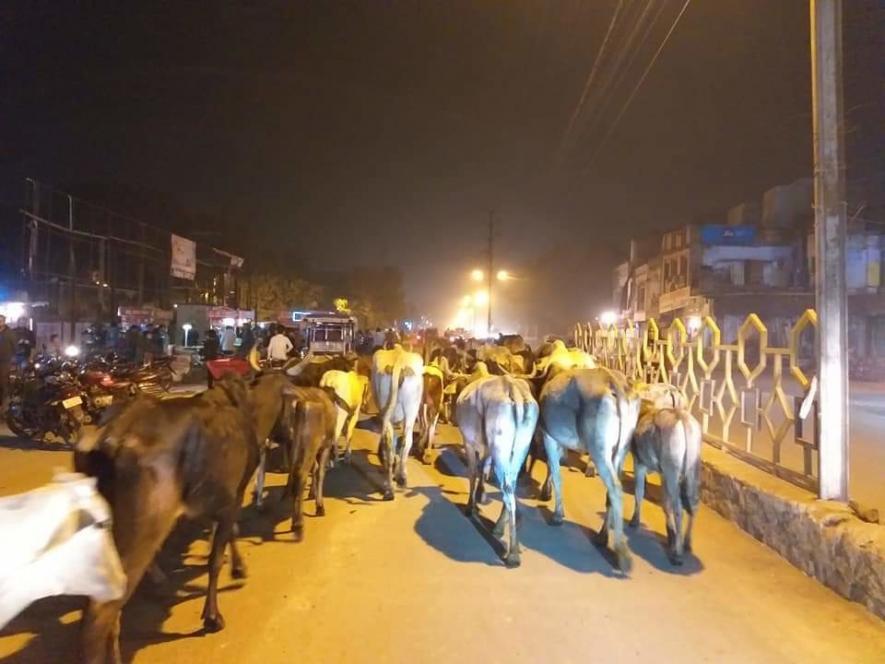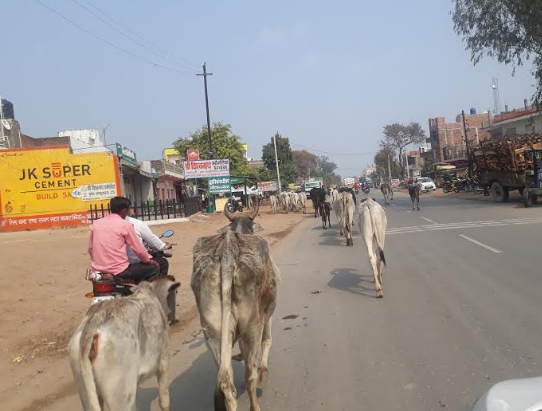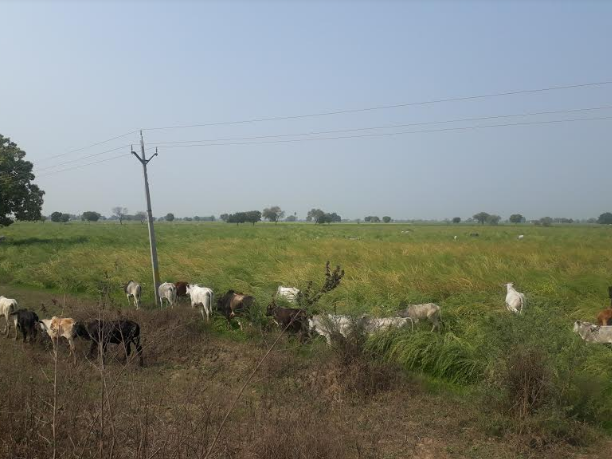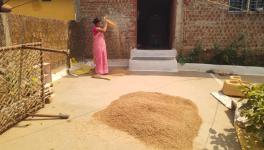Not MSP or Development, Stray Cows the Real Problem in Chambal in MP

[NewsClick travelled through the Chambal region, one of the most backward regions in Madhya Pradesh, to find out the condition of people and major issues facing them. This is Part 3 of a series of reports from Chambal.]
Gwalior / Bhind / Morena: After Uttar Pradesh, the stray bovine menace has reached Madhya Pradesh, with cattle rendering sleepless nights to the residents of MP’s Chambal region. Not only farmers but also the urban population claimed that stray cows have made their life hell.
Stray bovine are ruining standing crops, causing road accidents, killing and injuring commuters and above all, have become a major cause of mob lynching.
The Chambal region comprising of Gwalior, Bhind and Morena, is one of the most backward regions in Madhya Pradesh. Bhind and Morena are the bordering districts of Uttar Pradesh and Rajasthan. Rajasthan’s Dholpur (29) and UP’s Etawah (12 km) are merely half an hour away from both districts.
Residents of Morena and Bhind claimed that stray cattle menace which is rampant in UP and Rajasthan, is affecting their region as they form the bordering districts. “Farmers of both the states load their stray and unproductive cattle in trucks and leave them on MP’s border (on Chambal River) at night, and give them way to Bhind and Morena, which is proving to be a real trouble for us,” said a 48-year-old farmer Surendra Tomar of Bhind, while talking to NewsClick.
“Leaving cattle in another state is not a crime but the damage those animals are making is a crime and it's intolerable,” Tomar added.
The Municipal corporations have no data as to how many stray cattle are in the region. But according to a report published by a local newspaper Dainik Ajay Bharat, in Gwalior town alone, there are more than 2 lakh stray bovines. As per the estimate, there are more than 20 lakh stray cattle in the region or may be more.
Also Read: The Politics of Seizing ‘Life-Cycle’ of Cows
Owing to the sheer number of cattle, half a dozen people died and nearly a dozen received major injuries last year in Chambal-Gwalior region alone, claimed a Gwalior-based senior journalist Ravi Shekhar adding that stray cattle are making newspapers headlines everyday.
NewsClick talked to a number people in the Chambal region, who belong to different occupations-- farmers, tour operators, businessmen, residents and journalists-- over the issue. All hailed the issue of stray cos as the biggest problem in one voice.
A cab operator, Brijesh Kumar Sharma said, “Earlier, there were no good roads, but now, no roads are left to drive because of stray cattle, not even in Gwalior town. It is too difficult to drive even on the national highways because stray cattle sit or lie down on the roads, day and night.”

He further said, “First of all, villagers abandon their cattle on the roads, and if by any mistake, a car hits any of them, they rush to beat or extort the drivers. In case, the driver belongs to the minority community, they don’t spare any mercy. This is insane. The government must do something, if they are refraining us from selling or slaughtering the cattle,” Sharma insisted.
What are the Farmers Losing?
Farmers are worst hit with by the stray cattle menace and are losing almost everything. No matter whether it is a chilly night or the rainy season, farmers with fields are forced to stay up all night to protect their crops and keep a watchful eye on the movement of these herds.
“Stray cattle makes our life hell. After putting too much pain and labour, we grow our crops and stray cattle destroy them within hours. We stay up all night to guard the crops. If we doze off for a while despite sitting in the fields, they graze on our crops and ruin it,” said 50-year-old Ram Lakhan Pathak of Belaithe panchayat of Gwalior district.

On January 8, 2019, Mahaveer Prasad, a farmer and resident of Sambalgarh (Morena) received multiple injuries when he tried to shoo away stray cattle from his field and they attacked. Somehow, he managed to escape but cattle had ruined his filed at one go. Later, he reported the matter to Sub Divisional Magistrate and CM helpline but all in vain.
This is not the only incident, stray bovines killed two farmers in Sambalgarh a couple of months ago when they were trying to protect their fields.
Also Read: Congress’s Hindutva Card: NSA Against 3 for ‘Cow Slaughter’ in MP
When NewsClick visited the Rasidpur village of Gwalior district, villagers claimed that they are forced to guard their fields for the entire night from stray cattle because they can’t afford to get their crops destroyed by stray cattle.
“I couldn’t sleep for a minute since cows and bulls kept roaming freely during the whole night. I kept shooing away the cattle,” said 65-year-old Hakam Singh, a farmer of the village.
Ram Krishan, a farmer leader claimed that since stray cattle have created a havoc among the farmers, it is adversely affecting their health and normal life. “They don’t sleep properly, they don’t eat properly, they can’t go anywhere from the fields in a bid to protect it from cattle. All the time they are worried about their fields and spend most of their time there.”
Farmers from Rasidpur claimed that since the union government framed stringent laws against selling of bovines, all nearby animal markets have been shutdown. This in turn has forced the people to abandon to abandon their cattle, when they become unproductive.
“Due to our religious issues, we never attack even the stray cattle but if the government fails to address this issue, people may be forced to look for other solutions,” Ram Krishan added.
In some villages, with the help of others support, villagers have made temporary cow sheds and started keeping the stray cattle there, which costs Rs 20,000-25,000 a month.
The condition is similar in all three districts -- Gwalior, Morena and Bhind -- instead of minimum support price, farmers are being forced to demand an end to the stray cattle menace.
What has the State Government Done?
In its election manifesto, Congress had promised to open cow sheds at every panchayat of the state, if voted to power. There are more than 2,300 panchayats in the state. As promised, a month after forming the government, in the first phase, the new Congress government had announced to open 1,000 cow sheds with a cost of Rs 4,500 crore.
Also Read: Eyeing Hindu Vote Bank, Congress to Open 1,000 Cow Sheds in 4 Months, at Cost of 4500 crore
District Collectors have been asked to find a suitable place for the cow shed and submit the proposal to the Animal Husbandry Department.
Besides, the Kamal Nath government has hiked per day fodder allowance from Rs 4.5 to Rs 20, given to cow shed owners per cow. In addition, on the lines of the UP government, Congress is also mulling over the imposition of ‘cow cess tax’.
According to the 2012 animal Census, there were 1.96 crore cows in Madhya Pradesh. Of them, 4.37 lakh were stray cattle, of which, 1.50 lakh (mainly stray cattle) were kept in 604 cow sheds run by the NGOs with government’s support, and the rest were unclaimed and abandoned.
On the basis of cattle/oxen growth rate, recorded between 2007 to 2012 census, NewsClick has calculated that by 2018, there were likely 1.75 crore bovines in MP, of which, 62.81 lakh were either stray or unproductive.
In that situation, it is hard to say that opening of 1,000 cow sheds will solve the cow menace in the state.
What led to the Rise of the Problem?
The genesis of the problem lies in the paranoia created around cow slaughter by India’s ruling party and its supporters.
According to the rules, notified by the Ministry of Environment, Forest and Climate Change on May 23, 2017, purchase of cattle from animal market is prohibited.
Under a notification, titled the Prevention of Cruelty to Animals (Regulation of Livestock Markets) Rules, 2017, those who wish to sell cattle — bulls, cows, buffaloes, steers, heifers and camels — may do so only after they formally state that the animals have not been “brought to the market for sale for slaughter”.
The notification came in 2017 but people of the Chambal region claimed that this has been happening from the last four and a half years, since the Bharatiya Janata Party came to power in the centre.
“Since the BJP stormed to power in the centre and started cow politics, and the reports of mob lynching and attack on cattle traders began, the fear of mob violence has disrupted the cattle trade in the region,” claimed Bhind-based journalist Ramanand Soni.
With the news of violence, the sell, purchase and mobility of cattle was affected. “Unable to sell old and infirm animals for other purposes, people including dairy farmers started releasing them into the open. Stray cattle are rampaging through standing crops, causing losses to farmers. Government has announced to open cow sheds but I don’t think it will solve the problem of Chambal region, ” said Ramanand Soni.
See More: Cattle Menace: Gaushalas Not a Solution, Lift Ban on Slaughter, Say UP Farmers
Get the latest reports & analysis with people's perspective on Protests, movements & deep analytical videos, discussions of the current affairs in your Telegram app. Subscribe to NewsClick's Telegram channel & get Real-Time updates on stories, as they get published on our website.
























